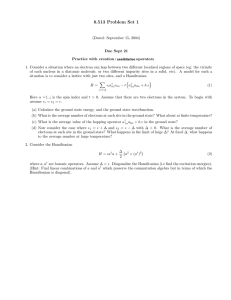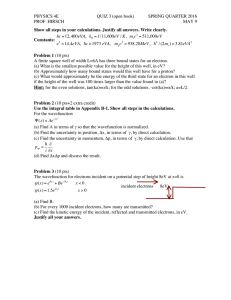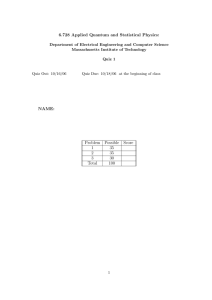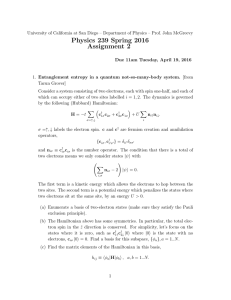Starting to talk about electronic structure methods CHEM 430 Spring 2016
advertisement
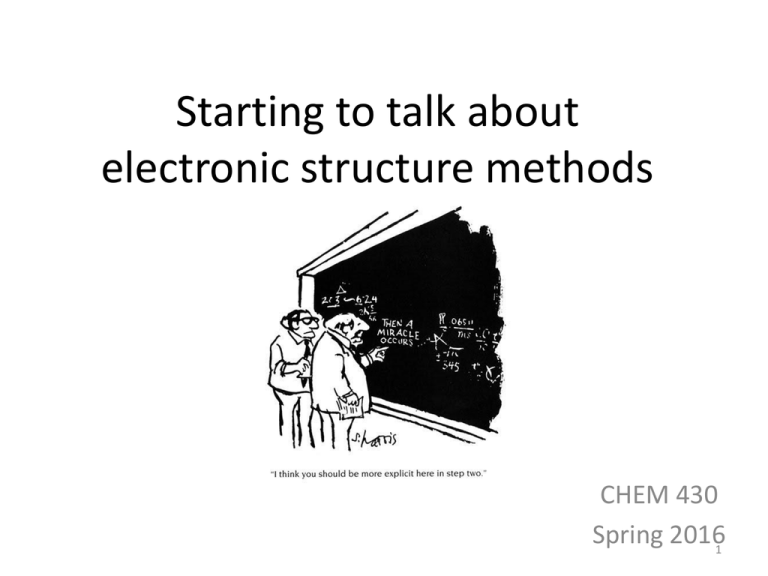
Starting to talk about electronic structure methods CHEM 430 Spring 20161 Computational chemistry • Study molecular structures, energetic properties, and molecular interactions which are difficult to obtain in a lab – Examples include dangerous molecules, transition states • Eliminate health and safety issues • Compare to and aid experimental work 2 Method selection 100 fs, 10 atoms: photochemistry Correlated Method (MP2, CCSD) Molecular detail Atomistic MM 10 ms, thousands of atoms: protein folding, drug binding Density Functional Theory 10 ps, 100 atoms: chemical reactions Coarse-grain 1 ms+, 1 million atoms: dynamics of large proteins, cell membranes, viruses Computational cost 3 A few limitations • Computational cost – Computer processing unit (CPU) time, memory, disk space • Molecular size – How many heavy (non-hydrogen) atoms? • QMtreat smaller systems (dozens of atoms…depending on the method…more later) • MMLarger systems (e.g., proteins) 4 Distinctions Molecular mechanics • Classical physics • F=ma • Continuum of values Quantum Mechanics • Ab initio • Schrodinger equation • Eigenvalues, eigenfunctions, operators, observables, wavefunctions Dirac, early 1900s 5 Quantum mechanics Schrodinger equation Ĥ E • Ĥ is the Hamiltonian operator • Ψ is the wavefunction • E is the energy Chemistry Physics QM Mathematics 6 Ĥ E Eigen… Qopψi= qiψi • Eigenvalue – Correspond to an eigenfunction (and eigenstate) – Each eigenfunction has a set of eigenvalues that are possible from making a measurement on a system – Eigenwert (Characteristic value) • Eigenfunction – Eigenfunktion (Characteristic function) 8 Ĥ E Qopψi= qiψi • Operators (Qop) – Transform one function to another – Applied to wavefunctions to determine properties – Operator for the energy is the Hamiltonian – Operation of the wavefunction is the Schrodinger equation – There is an operator for every physical observable • Observables – Each observable corresponds to a linear operator – E.g., position, momentum, energy 9 Ĥ E Wavefunctions • Probability map…where spatial amplitude (dependent on x,y,z) is large, good chance you will find your system there • Describe the state of a system • Contain the measureable information about the system • Operator on the wavefunction 2 • Must be ( x, y, z, t ) dxdydz 1 – 1.) Normalizable – 2.) Continuous (and its derivative) – 3.) Single-valued 10 Ĥ E Radial and angular (r, , ) R(r )Y ( , ) Y ( , ) ( )( ) • Solve Schrodinger equation via separation of variables • r is distance from center of nucleus, θ is the angle to the positive z-axis, and φ is the angle to the positive x-axis in the xy-plane • Each set of quantum numbers (n,l,ml) describes a different wave function • Radial depends on n and l • Angular depends on l and ml 11 Time-dependent Schrodinger equation V ( x) i 2 2m x t 2 2 H i t • Wavefunction evolves with time and behaves like a wave • Newton’s equation (F=ma) gives us position of a particle as a function of time • Schrodinger equation gives us Ψ(x,t) where square of the wavefunction tells us the probability of finding the particle in space as a function of time 12 Removing the time dependency H i t ( x, y, z, t ) ( x, y, z) (t ) d ( H ) i dt 1 d 1 ( H ) i dt 1. 2. 3. 4. (0) (1) (2) (3) Consider a form of Ψ such that time and position variables can be separated Put right-hand side of (1) into (0) Rearrange (2) LHS of (3) depends on t and RHS depends on x,y,z (therefore, LHS and RHS equal the same constant) 13 Removing the time dependency d E i dt 1 d 1 ( H ) i dt (t ) e iEt / ( x, y, z, t ) ( x, y, z )eiEt / • • C 1 ( H ) C ( H ) H E RHS is in form of operator equation (H is Hamiltonian so C is energy, E) LHS must equal E…1st order differential equation 14 Time-independent Schrodinger equation Ĥ E Hˆ Tˆe Tˆn Vˆne Vˆnn Vˆee nuclei 1 electrons nuclei e 2 Z nucleie 2 Z Z electrons e 2 1 A A B Hˆ i2 2A i A 2 i A A B i j 2 riA rAB rij electrons • To find what the wavefunction is for a certain energy means we need to remove the time dependence We can make approximations to simplify this even more! 15 Born-Oppenheimer approximation • Nuclei move much more slowly than electrons (mnuclei ≈ 1800melectron ) • Decouple nuclear and electronic motion (find electronic energies for fixed nuclear positions) • Nuclei move on a potential energy surface which is a solution to the electronic Schrodinger equation – PES is independent of nuclear mass • Allows us to determine equilibrium and transition state geometries Nucleus Electron 16 Adiabatic approximation • The form of the total wavefunction is restricted to one electronic surface • If the system starts in one eigenstate of the Hamiltonian, it will remain in that eigenstate from initial to final (of an adiabatic process) • Time-derivative of the Hamiltonian is small This and the BO approximation break down when ≥ 2 solutions to the Schrodinger equation are close energetically 17 Schrödinger Equation Ĥ E Hˆ Tˆe Tˆn Vˆne Vˆnn Vˆee Constant 0 nuclei 1 electrons nuclei e 2 Z nucleie 2 Z Z electrons e 2 1 2 2 A A B Hˆelec i A i A 2 i A A B i j 2 riA rAB rij electrons • Assume: Born-Oppenheimer approximation Nucleus Electron 18 Scaling Method and basis set Number of basis functions CBS “Exact” solution to HΨ=E Ψ 6Z 5Z QZ TZ DZ Hartree-Fock DFT MP2 CCSD CCSD(T) Full CI Increasing Cost • Scaling • Memory, computer processing time 19 Desirable qualities in a method 1. 2. 3. 4. Size extensive Size consistent Variational Accurate 20 Size extensive Energy • Correct (linear) scaling of a method with the number of electrons • Lack of size extensivity implies errors from the exact energy increase as more electrons enter the calculation Electrons 21 Size consistent • “Non-interacting limit” description • “Additive separability” of the wavefunction • Entire PES must be correctly described as we bring two non-interacting H2 molecules close together H2 2 H2 Ea = r=∞ Eb H2 22 Variational principle • Choose an arbitrary wavefunction and vary it until you find the lowest energy • Boundedness by ground state energy, E0 * H dr * E0 23 Accuracy • Gold standard in QM: CCSD(T)/aug-cc-pwcv(5+d)z-DK …method/basis set (more later) Ea RT Expt. k Ae kcalc 0.1 10 kexpt Theory • Ideally, want calculated and experimental rate constants to be within one order of magnitude from each other • Therefore, at 298K, theoretical energy should be within one kcal/mol of experimental value 24 Solving the Schrodinger equation • Can be solved exactly for a one-electron system • Start adding in more electrons… • Initial assumption: Pretend electrons don’t interact (Vee=0) – Then Hamiltonian is separable and total electronic wavefunction Ψ(r1,r2) describing motion of two electrons is product of the two wavefunctions, Ψ(r1) Ψ(r2) • Hartree Product HP (r1 , r2 ,..., rN ) 1 (r1 )2 (r2 )...N (rN ) • Fails antisymmetry principle • A wavefunction describing fermions should be antisymmetric with respect to the interchange of any set of space-spin coordinates 25 Solving the Schrodinger equation For two electrons… 1 1 1 ( x1 ) 1 ( x1 ) 2 ( x2 ) 1 ( x2 ) 2 ( x1 ) ( x1 , x2 ) 2 2 1 ( x2 ) 2 ( x1 ) 2 ( x2 ) If you put two electrons in same orbital at same time… ( x1 , x2 ) 0 For N electrons… 1 N! 1 ( x1 ) 1 ( x 2 ) Pauli Exclusion Principle! 2 ( x1 ) ... N ( x1 ) 2 ( x2 ) ... N ( x2 ) ... ... ... ... 1 ( xN ) 2 ( xN ) ... N ( xN ) Slater determinant 26 Solving the Schrodinger equation Simplifying the Hamiltonian Hˆ electrons i 1 2 electrons nuclei e 2 Z A electrons e 2 nuclei e 2 Z A Z B i 2 riA rij A B rAB i A i j Hˆ elec h(i) v(i, j ) VNN i i j • Next up Hartree-Fock and self-consistent field! 27 Approximate solutions to Schrödinger equation Schrödinger’s equation is nearly impossible to solve, so approximate methods are used. 2 æ Ñ ç -å i - å Z I + å 1 ç è i 2 i,I R I - r̂i i¹ j r̂i - r̂j HF 1 1 2 1 ö ÷ Y ( ri ) = EY ( ri ) ÷ ø 1 2 1 N 2 2 2 N N 1 N 2 N N Slater determinant: Use wavefunction of noninteracting electrons for interacting system 0 r 0 r1 , r2 , r3 ,, rN E Density functional theory: The ground-state electron density contains all information in the ground-state wavefunction • Electron repulsion makes this problem difficult • Approach 1: Use approximate wavefunction forms (QM) • Approach 2: Use the electron density as the main variable (DFT) • Approach 3: Approximate the energy using empirical functions (MM) E ( R I ) ® kIJ ( RIJ - RIJ0 ) 2 Molecular mechanics: Use empirical functions and parameters to describe the energy (e.g. harmonic oscillator for chemical 28 bond)
